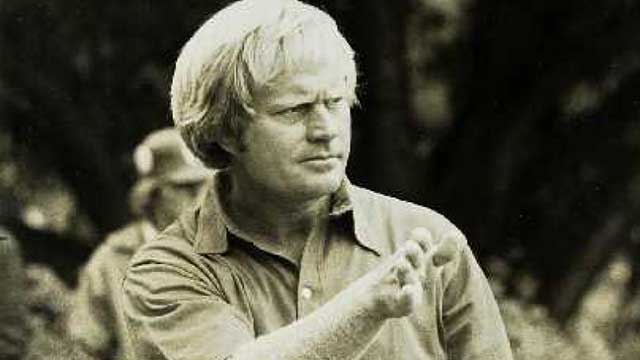NEWS
What the "edge" means to golfers

AUGUSTA, Ga. -- In Michael Bamberger's fascinating new book, "Men in Green," he recalls a candid conversation with Arnold Palmer in which the man who started it all in golf explained the difference between guys who win a tournament or two and those who dominate.
The difference is what Palmer called "The Edge," an obsession with winning and mastering a most confounding game. Those few who find it become Arnie, Jack or Tiger, needing only one name to be recognized.
Those who don't find The Edge, or who can't hold it for long, win a few trophies but not enough to make the game remember them. If they are remembered, they require two names.
Golf's edge is a dangerous thing, as edges often are. It is thin, sharp and easily lost, like a perfectly honed skate blade. When you're on it, you glide. When you lose it, you tumble.
Which brings us to Tiger Woods.
"It's so fine," Palmer said. "You have to get in there, and you have to stay in there, and once you get out, it's very hard to get back in. It's happened to every golfer. Hogan. Nicklaus. Every golfer. It's just a question of when."
Palmer lost it, he said, sometime after winning the U.S. Open at Cherry Hills in 1960. Even though he won four more majors and a host of other tournaments, the obsession that once made him beat balls until dark began to fade. He still wanted to win but didn't consider it a life-or-death proposition. The Edge was gone.
"Winning that first U.S. Open was an obsession," Palmer said. "Then, after you win it, you have to stay aggressive, stay the way you were when you won it. And it's difficult to do."
Which brings us back to Tiger Woods.
Once the dominant force in golf, Woods has not won a major in nearly seven years and hasn't won the Masters in 10. He returns this week after a two-month layoff forced by a bad back and a case of the chipping yips that resulted in his being whisked away on a golf cart after laboring through 11 holes at the Farmers Insurance Open.
That came a week after he shot the highest round of his career at a non-major, an alarming 82 in Phoenix that included six bogeys, two doubles and a triple. His wedges refused to comply with his demands, and his driver was like a foreign object in his hands.
As season openers go, it was considerably less than encouraging after a tough 2014 in which he played in only seven tour events and failed to register a top-10 finish. Worse, Woods' pursuit of Jack Nicklaus' 18 major championships remained becalmed. He was unable to play in either the Masters or U.S. Open, finished 69th at the British and failed to make the cut at the PGA. Like all those before him who once ruled golf's lush landscape, it seemed he too had lost The Edge.
Palmer knows the feeling, but Woods has not given in. Yesterday, he repeatedly explained his problems as being "stuck between two release patterns." He hasn't lost The Edge. He simply became trapped between the yin and yang of two golf swings.
He was like a new man, at least outwardly. He was unusually engaging, smiling and laughing while insisting "I worked my ass off'' when asked what he'd been doing the past eight weeks.
"That's the easiest way to kind of describe it,'' he said. "I worked hard. People would never understand how much work I put into it to come back and do this again. It was sunup to sundown and whenever I had free time, if the kids were asleep, I'd still be doing it. When they were in school, I'd still be doing it.
That is the only way The Edge remains. It must be honed constantly, obsessed about, focused on in a way that is frankly unhealthy and unbalanced.
Woods kept returning to that theme as he assured his questioners that "I needed to have all facets of my game come around. They all have." He said while others have noted his more convivial demeanor around his competitors and couldn't help but ask about a brief moment when he broke into dance as hip hop music blared through his ear buds as he practiced, nothing had changed.
"My greatest motivation?" he said. "Winning. I like it."
Woods was convincing in both manner and explanation of the long hours he spent trying to locate his long-absent game. He was convincing when insisting he wants to beat the new generation of players as much as he once did Phil Mickelson or Vijay Singh, and surely he does. But the return of The Edge? That's a different matter.
"I'm just enjoying competing again," Woods explained. "Whether I have blinders on or not, I don't feel any different. I feel like I'm preparing to try and win the Masters."
Surely he does, but not with The Edge. Woods unwittingly made that clear when asked if his two young children were with him when he was working "sunup to sundown" on the range.
"Absolutely,'' he said. "We had a lot of games. Pick flowers, play tag, run around, play obstacle. Play distraction. Yes, they were there."
It was a nice story about a father and his kids, but it made you wonder. Back when he was winning all those majors, do you think anyone was playing tag or picking flowers on the range when he practiced?
Arnold Palmer would doubt it.
This article was written by Ron Borges from Boston Herald and was legally licensed through the NewsCred publisher network.
